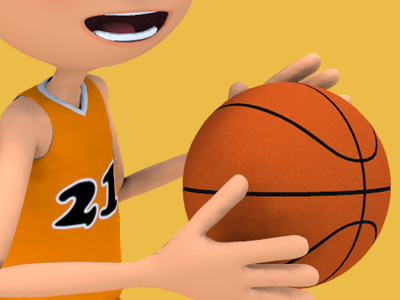Basketball

Basketball Violations
The ball may be advanced toward the basket by being shot, passed between players, thrown, tapped, rolled or dribbled (bouncing the ball while running).
The ball must stay within the court; the last team to touch the ball before it travels out of bounds forfeits possession. The ball is out of bounds if it touches a boundary line, or touches any player or object that is out of bounds.

There are limits placed on the steps a player may take without dribbling, which commonly results in an infraction known as traveling. Nor may a player stop his dribble and then resume dribbling. A dribble that touches both hands is considered stopping the dribble, giving this infraction the name double dribble. Within a dribble, the player cannot carry the ball by placing his hand on the bottom of the ball; doing so is known as carrying the ball. A team, once having established ball control in the front half of their court, may not return the ball to the backcourt and be the first to touch it. A violation of these rules results in loss of possession.
The ball may not be kicked, nor be struck with the fist. For the offense, a violation of these rules results in loss of possession; for the defense, most leagues reset the shot clock and the offensive team is given possession of the ball out of bounds.
There are limits imposed on the time taken before progressing the ball past halfway (8 seconds in FIBA and the NBA; 10 seconds in NCAA and high school for both sexes), before attempting a shot (24 seconds in FIBA, the NBA, and Canadian Interuniversity Sport play for both sexes, and 30 seconds in NCAA play for both sexes), holding the ball while closely guarded (Five seconds rule), and remaining in the restricted area known as the free-throw lane, (or the "key") (Three seconds rule). These rules are designed to promote more offense.
Basket interference, or goaltending is a violation charged when a player illegally interferes with a shot. This violation is incurred when a player touches the ball on its downward trajectory to the basket, unless it is obvious that the ball has no chance of entering the basket, if a player touches the ball while it is in the rim, or in the area extended upwards from the basket, or if a player reaches through the basket to interfere with the shot. When a defensive player is charged with goaltending, the basket is awarded. If an offensive player commits the infraction, the basket is cancelled. In either case possession of the ball is turned over to the defensive team.
A defensive three-second violation, also known as illegal defense, is a basketball rules infraction in the National Basketball Association (NBA) introduced in the 2001–2002 season. It is assessed when a member of the defending team spends more than three seconds in the free throw lane (also known as the 16-foot lane, or colloquially as "in the paint") while not actively guarding an opponent.
In the sport of basketball, the bonus situation (also called the penalty situation) occurs when one team accumulates a requisite number of fouls, which number varies depending on the level of play. When one team has committed the requisite number of fouls, each subsequent foul results in the opposing team's taking free throws regardless of the type of foul committed (i.e., whether or not the foul was a shooting foul). Teams under the limit are commonly referred to as having fouls to give, and thus they can try to disrupt their opponents without being penalized free throws.

SPORTS

RESOURCES
This article uses material from the Wikipedia articles "Basketball", "Defensive three-second violation", "Bonus (basketball)", which is released under the Creative Commons Attribution-Share-Alike License 3.0.
© Stories Preschool. All Rights Reserved.












